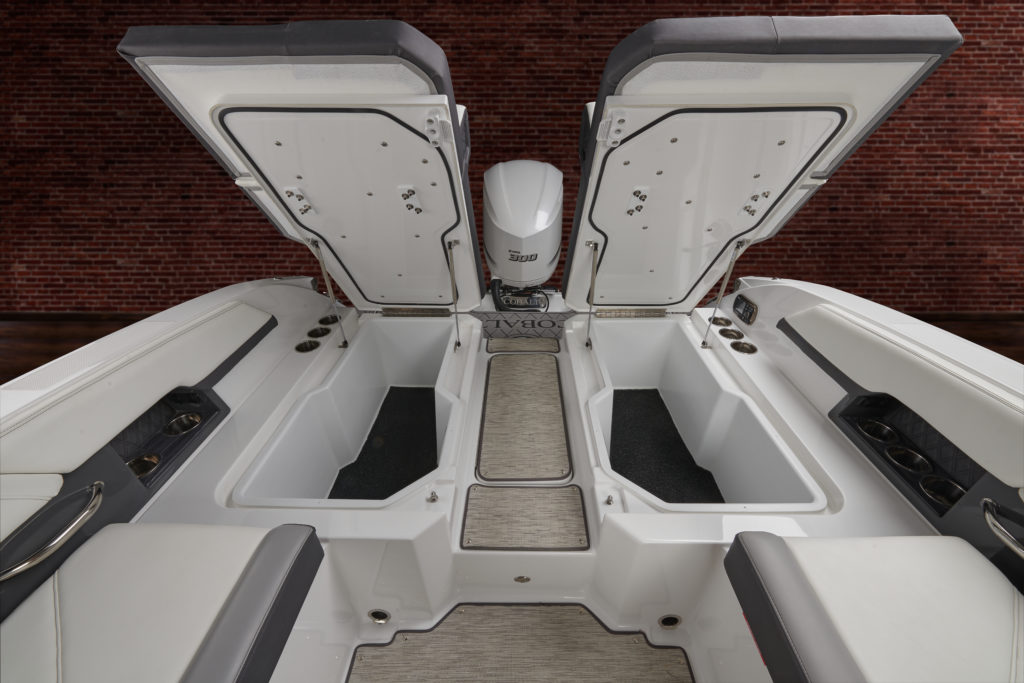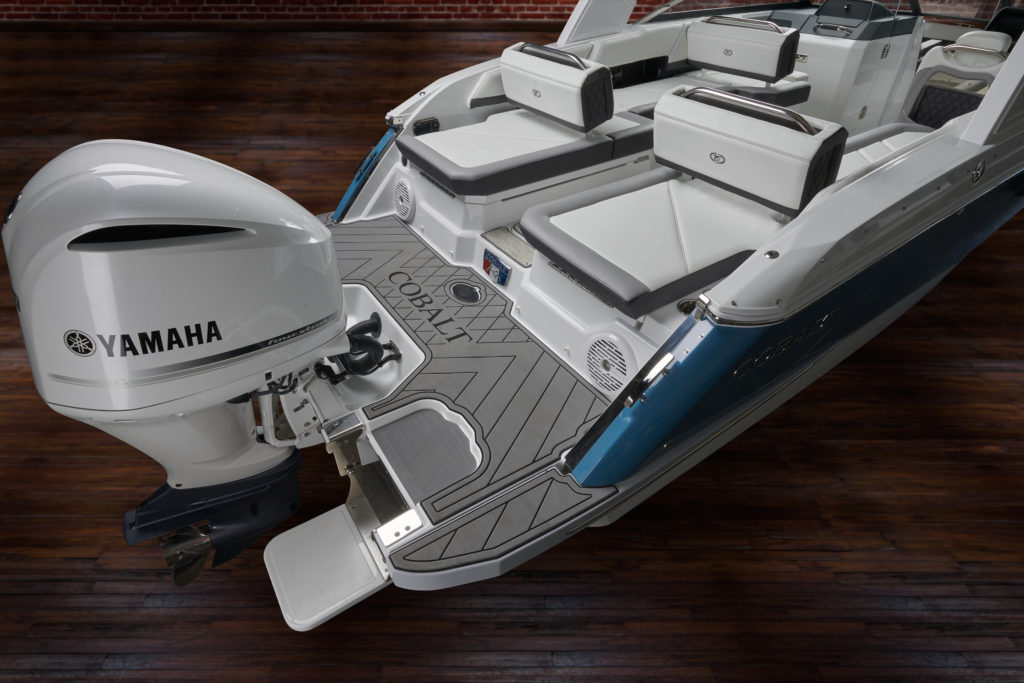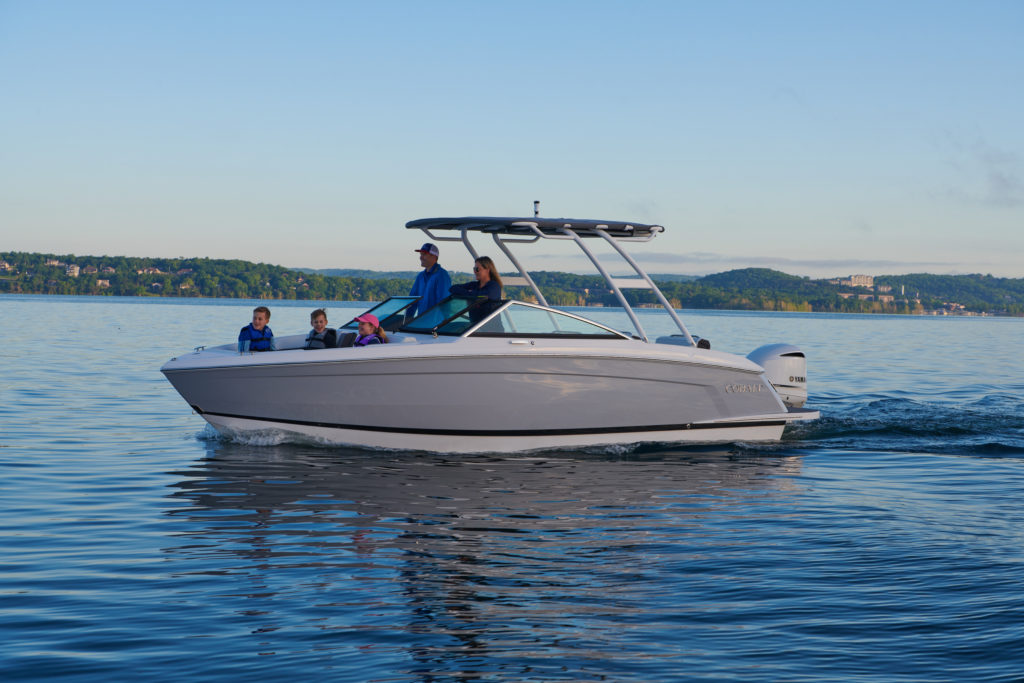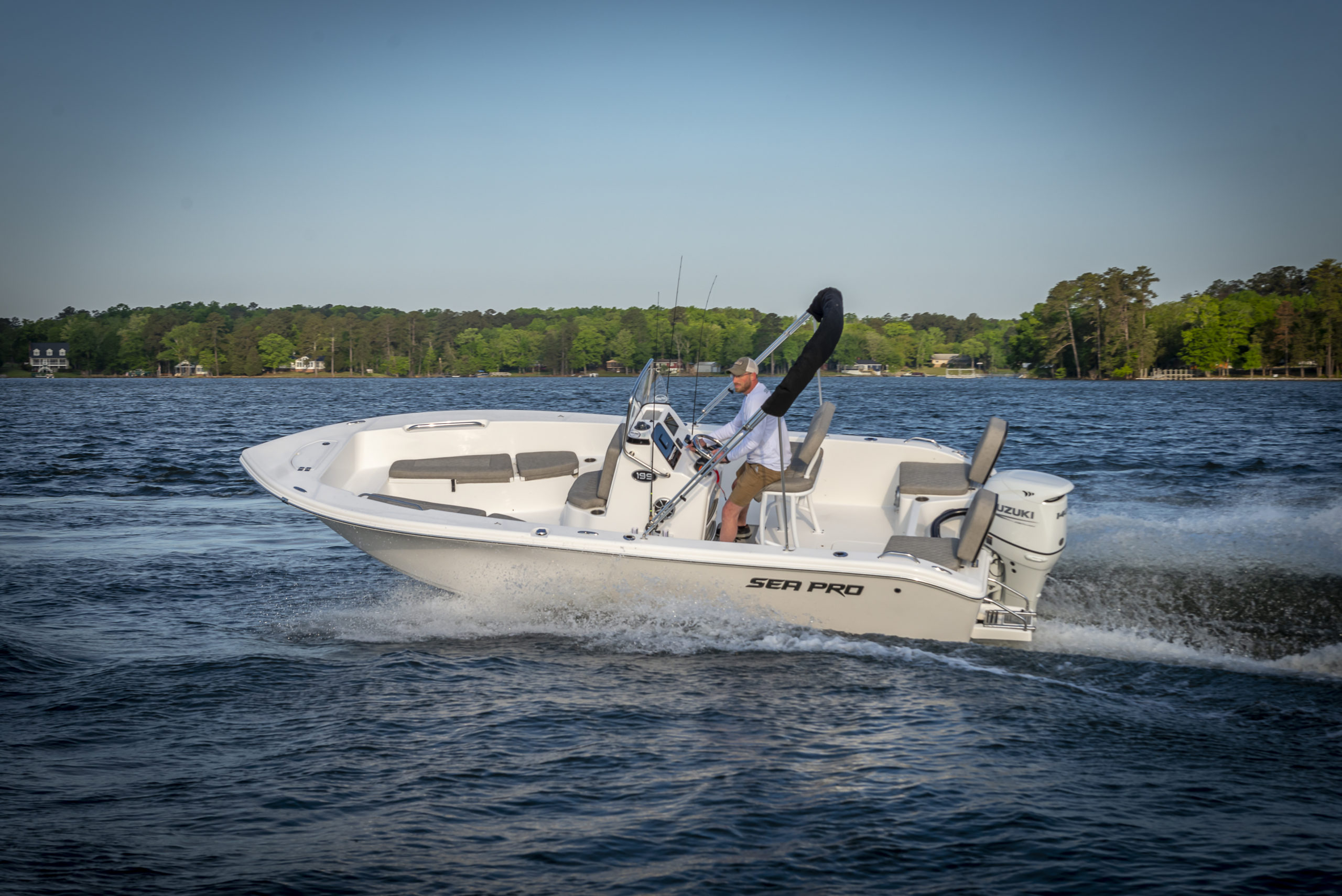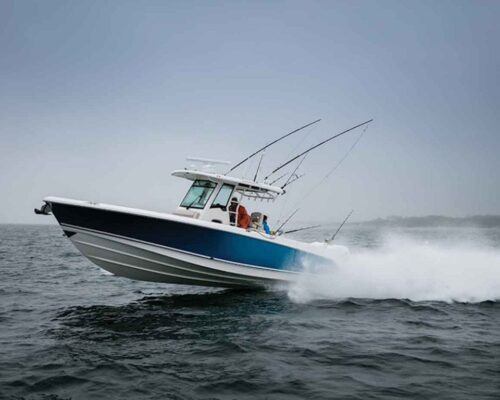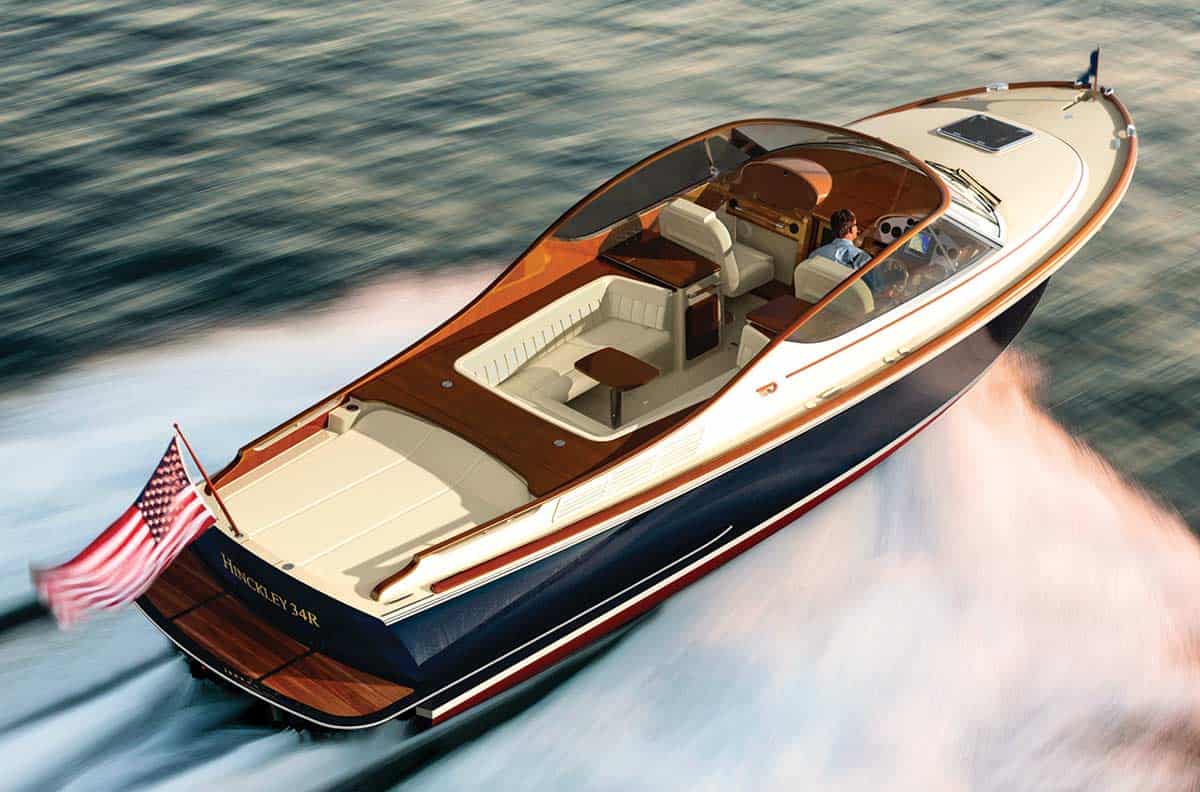Cobalt R6 Outboard
LOA: 25’5″
Beam: 8’6″
Draft: 17.5″/32.5″
Weight: 5,300 lb
Transom Deadrise: 18º
Max HP: 350
Fuel Capacity: 80 gal
Water Capacity: 10 gal
Bridge Clearance: 61.5″
(104″ w/ tower)
Persons Capacity: 14 (2,100 lb)
A family runabout’s first two jobs are to keep its people safe and comfortable. It should also perform adequately for exhilarating ventures such as day cruises, tubing and swimming, and sunset picnics. It should offer amenities specifically designed to support those activities. Moreover, as a major investment for any family, it should hold its value for however many years the family chooses to keep it.
Cobalt Boats have been checking all of those boxes for a long time, first under the ownership of the St. Clair family and, for the past four years, under the corporate ownership of Malibu Boats. The company has always offered inboard/outboard power from Volvo or MerCruiser, but the advent of large, powerful four-stroke outboards has made them favored choices in tidal waters like the Chesapeake. Cobalt’s strong naval architecture and engineering team has responded with hulls specifically designed for power from Yamaha and Mercury.
The subject of this review, the 25’5″ R6 Outboard, hits a sweet spot as a family runabout. It’s large enough to carry 14 people and tame a Chesapeake afternoon southerly but small enough to run well with 300–350-hp engines. While Yamaha’s F300 is a strong, durable engine, both Chesapeake Cobalt dealers prefer to rig the outboards with 300-hp V-8 or 350-hp I6 Mercury Verados, citing the engines’ quiet operation (which results from innovations in Mercury’s dedicated Noise/Vibration/Harshness engineering laboratory). “A single 300 is plenty fast,” said Bosun’s general manager, Jeff Truesdale of Grasonville, at the broad mouth of the Chester River. “With it, an R6 tops out in the low 50s, but not many families want to run that fast in Chesapeake seas. More to the point is the boat’s efficient, comfortable performance at speeds from the low 20s to the mid-30s. It cruises especially well at 3400 rpm, 25–26 mph.”
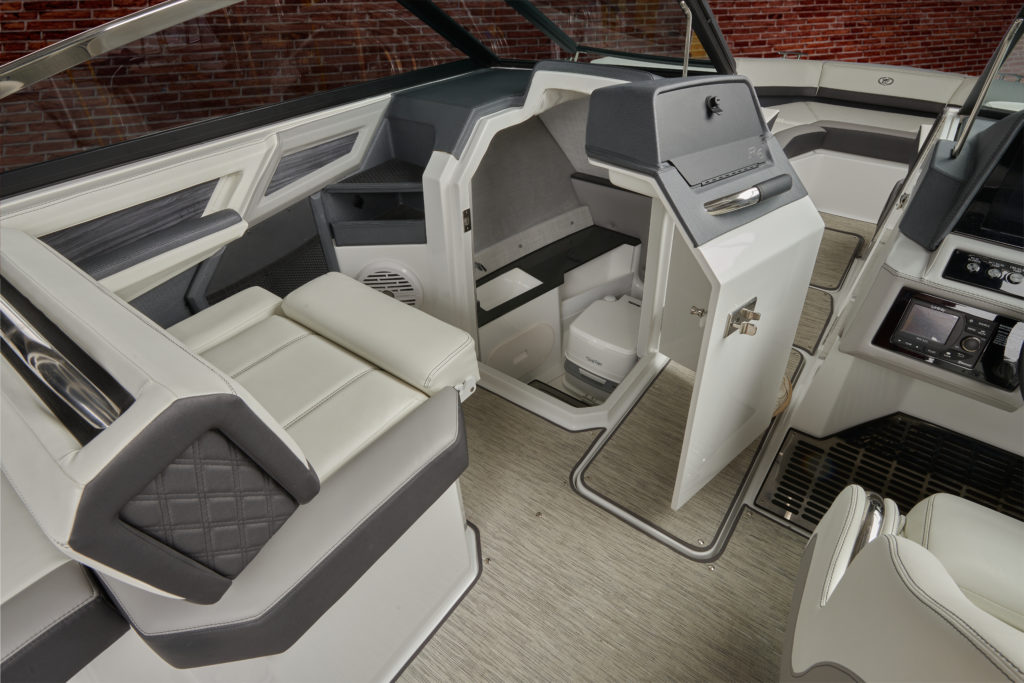
Credit Cobalt’s design team and lamination crews for that performance. Wide, sharp reverse chines and crisp lifting strakes damp spray and provide stability at rest, while an all-composite hull provides strength and enough weight to complement the shape for a soft ride with no rattles or shakes. The engine bolts to an integrated transom bracket, with balance carefully calculated around placement of tanks, batteries, seats, and people.
The outboard model has a sturdy, solid feel underway, with an 18-degree running bottom curving to a sharp bow. The R6 is a “terrific hull,” said Truesdale, “soft-riding with 16 layers of fiberglass set with vinylester resin, plus Kevlar in the keel.” Keith Carr, delivery captain at Prince William Marina on the Potomac, concurred. “We’ve had broad experience with Cobalts. Their performance is amazing. They draw ear-to-ear grins from customers. I’ve made deliveries in all sorts of nasty weather. There are no rattles, spray, or jarring. The boat will take more than we can. It’s a great size for the Bay and its rivers.”
While the R6 legitimately offers seating for up to 14 adults, most family outings will include fewer people who will find the R6 downright spacious, with details carefully planned by “people who run their own boats,” according to Prince William’s long-time President, Carlton Phillips. The bow deck holds an anchor locker for a through-stem plow anchor, with a windlass optional. Cobalt mounts eight-inch stainless cleats at the bow, amidships for spring lines, and astern. Phillips notes that they are supported by aluminum backing plates laid into the boat’s deck laminations. He also touts Cobalt’s stainless steel fender clips, quick-mount fittings installed in the decks at proper fender positions. The fender lines are pre-set, with stainless pins at their upper ends. When docking, simply insert the pin into the fitting and the fender hangs in the optimum position to protect the boat’s shining gelcoat.
The forward cockpit includes an L-shaped lounge to port and center, with a single seat to starboard. The area seats up to four, with cup holders and grab handles placed in appropriate locations. The double-stitched cushions, made of a material that remains cool to the touch on sunny days, rise on neatly fastened stainless piano hinges and gas struts to offer finished storage for fenders, life jackets, towels, and clothing. When lifted, the starboard seat provides service access to dashboard at the helm, including marine electronics and stereo.
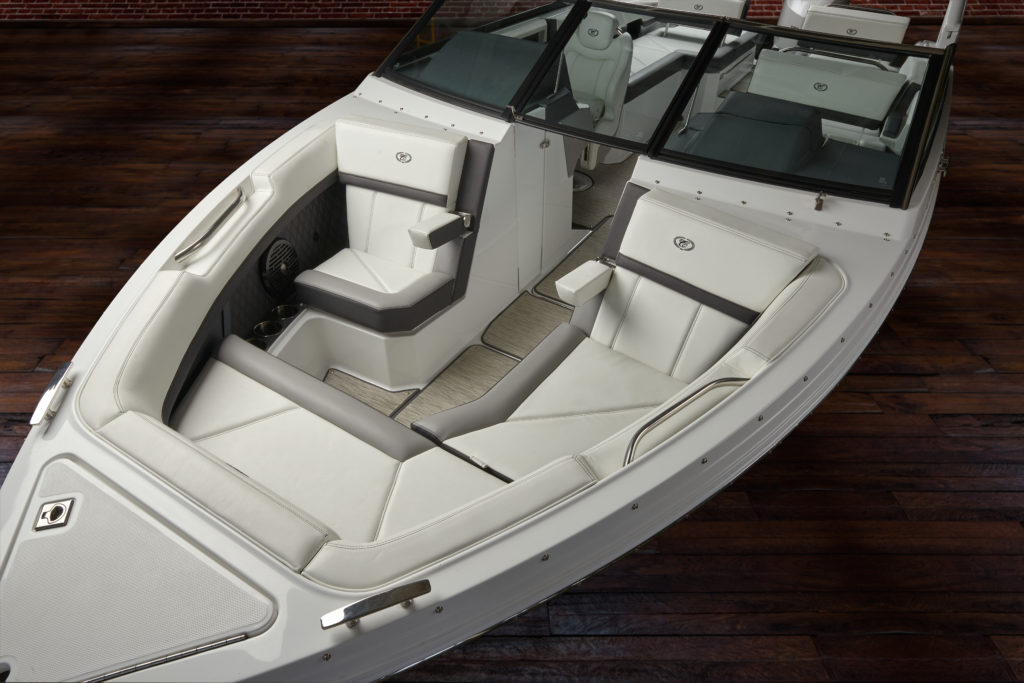
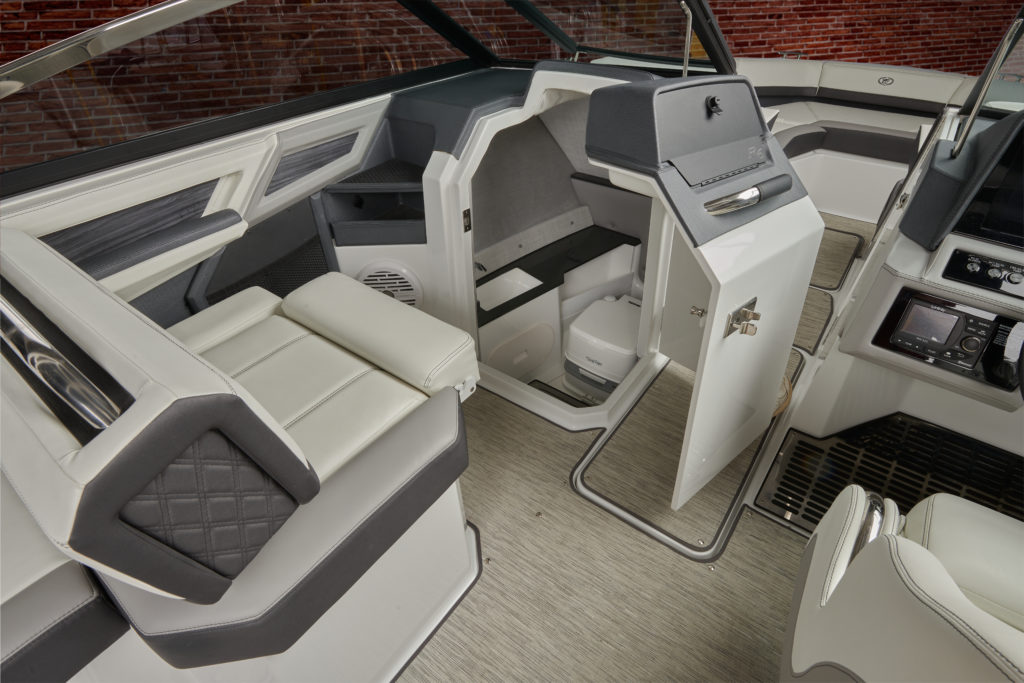
The walkthrough between the port (head) and starboard (helm) consoles includes a folding door and a center section that close tightly for snotty weather, with a long, cushioned storage space beneath the sole for objects like water skis, boards, and tow toys. Cobalt engineers shaped the port console’s door and hinges so that it swings free and opens wide for easy access backing in. The R6 hull is deep enough for the head to be “functional,” as Carlton Phillips puts it. We’d order the boat with a porcelain electric toilet, holding tank, and sink console. To starboard, the helm console offers a Garmin glass bridge, including a pair of 7″ or 10″ electronic touchscreen displays that provide sonar and charting along with engine data. Below lie a neat line of switches, there are rockers for trim tabs, controls for the stereo, and to starboard of the dash, an optional cell phone holder/wireless charger. The throttle/shift/trim lever mounts to the side. Both the swiveling helm and the fixed companion seat have a flip-up bolster for sitting higher while underway.
Multifunction settees extend down both sides of the R6’s cockpit. To port, the forward end forms the companion seat, but a swinging back on a robust, polished stainless steel frame allows the space to convert to an aft-facing lounge for observing folks riding tow toys. The after section of the port settee holds a similar seatback, which swings aft to provide a forward-facing lounge or forward to offer an aft-facing lounge for watching swimmers when the boat is on the hook or at a beach. The starboard settee offers the same aft folding backrest, as well as dedicated space beneath the bench for a carry-on cooler.
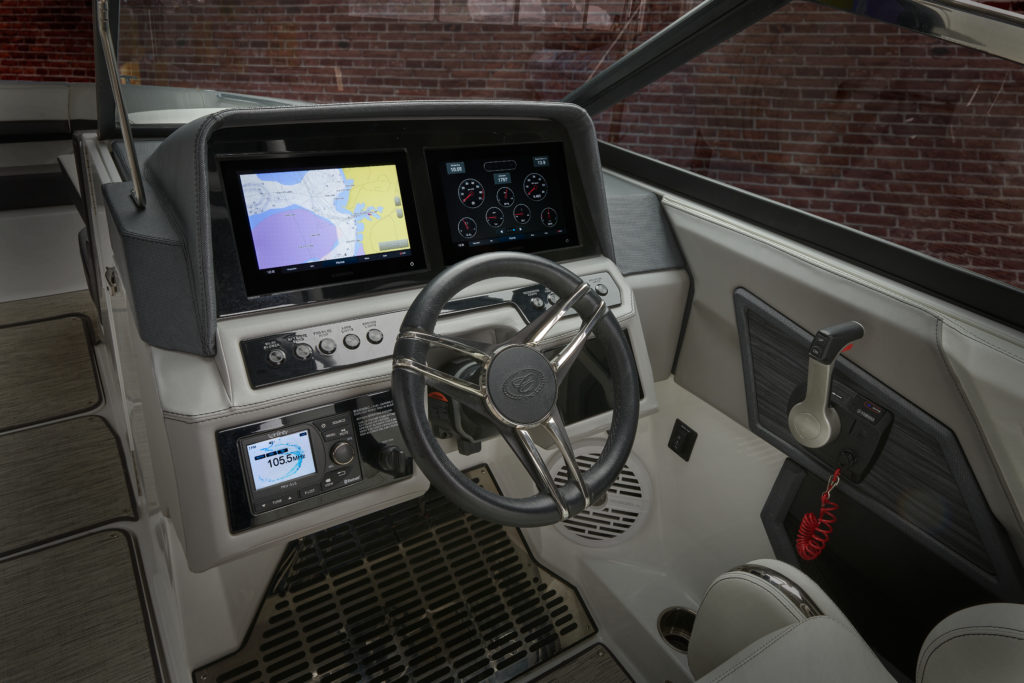
Look at the photos on the Cobalt website of the two settees with both after hatches raised. They tell a story about Cobalt’s attention to detail. First, obviously, there is additional storage there, and the bins lift out for service access to plumbing, wiring, and tanks in the bilge. But look closely at the two hatches, each rising on a stainless piano hinge and suspended by a pair of gas shocks. Notice that the undersides of the hatches are finished gelcoat, with gaskets shaped to fit the rims of the storage compartments. Note also the gutters along the rims, so any water that falls drains aft to the stern platform and overboard, not into the storage. Note the stainless bolts fastened with stopnuts and washers that hold all fittings, especially the two backing plates for each backrest hinge. Each hatch is a complicated part, but it is designed, fabricated, and assembled to last. While you’re looking at that picture, notice the placement of cupholders both fitted into topside pockets for those sitting forward on the settee and on the ledges just outside the aft cushions for people lounging there with the seatbacks set for facing aft. Observe also the scuppers in aft end of the cockpit. Any water that might find its way onto the cockpit sole drains to gutters running along both sides, which lead to those two scuppers. They, in turn, lead through the transom and overboard.
A central walkway between the settees conveniently leads back to a deep, full-beam swim platform at the transom. Here the advantage of single-engine power shows. With the seatbacks set aft-facing, they and the stern deck form a happy space that can serve multiple swimmers and spectators, thoughtfully including stereo speakers and a switch to control them on the port side.
To starboard of the engine is a flip-down swim step, an ingenious, patented Cobalt feature. The nonskid step hangs on two sturdy, polished stainless steel straps that allow it to stow in a pocket on top of the platform, secured with a simple, spring-loaded lock. When released, it flips over to form a secure in-water step for a person climbing into or out of the water. A telescoping ladder to port is an option.
“Cobalt is all about customer satisfaction,” remarked Jeff Truesdale. “Customers often say I want one because that was my grandfather’s boat.” Carlton Phillips agreed. “Malibu has carried on the tradition the St. Clair family established. They work with us well, especially under today’s difficult circumstances. These are sturdy, well-built boats. Cobalt sticks with tried-and-true. When something works, it works. People keep their Cobalts and take good care of them.”
Base MSRP at press time for an R6 Outboard with a 300-hp Mercury Verado V-8 is $131,298. Cobalt offers a Design Your Dream section on its website to fit out an R6 with a full range of options.
